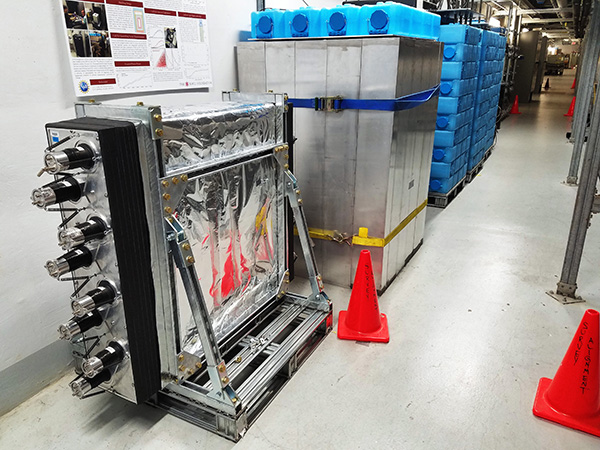Sandia plays key role in experiment to measure coherent elastic neutrino-nucleus scattering

Sandia researchers have helped solve a mystery that has plagued physicists for 43 years. Using the world’s smallest neutrino detector, the Sandia team was among a collaboration of 80 researchers from 19 institutions and four nations that discovered compelling evidence for a neutrino interaction process.
The breakthrough paves the way for additional discoveries in neutrino behavior and the miniaturization of future neutrino detectors. Neutrinos, elementary subatomic particles with infinitesimal mass and with no electric charge, are extremely challenging to detect.
The COHERENT project was led by DOE’s Oak Ridge National Laboratory (ORNL). The research was performed at ORNL’s Spallation Neutron Source (SNS) and has been published in the journal Science titled “Observation of Coherent Elastic Neutrino-Nucleus Scattering.”
The research team was the first to detect and characterize coherent elastic scattering of neutrinos off nuclei. This long-sought confirmation, predicted in the particle physics Standard Model, measures the process with enough precision to establish constraints on alternative theoretical models.
David Reyna, manager of Remote Sensing Dept. 8648 at Sandia’s California laboratory, was instrumental in the COHERENT experiment. David spearheaded a 2012 workshop at Sandia that brought together leaders and researchers in the neutrino field. David and Sandia researcher Belkis Cabrera-Palmer (8647) also oversaw the deployment of multiple detectors at ORNL as part of the COHERENT collaboration.
“We have a long history at Sandia of investigating low-energy neutrino detection techniques with potential applications to reactor monitoring,” says David. “For many years we have been working with the community on the development of low-threshold germanium detectors for potential Coherent elastic neutrino-nucleus scattering detection.”

One-of-a-kind research facility
Belkis was in charge of analyzing three years of neutron background data collected with the Sandia-developed neutron scatter camera in five different locations across the SNS, a one-of-a-kind research facility that produces neutrons in a process called spallation.
“Fast turnaround of the analysis results guided the collaboration in deciding the location with background low enough to allow for detection,” says Belkis.
David and Belkis also supported the initial deployment of a High Purity Germanium Detector in collaboration with Lawrence Berkeley National Laboratory. Currently, David and Belkis are working on the deployment of a Sandia-developed high-energy neutron detector, the Multiplicity and Recoil Spectrometer, for the project. Belkis will lead the deployment, simulation, and analysis of the detector, which is scheduled to continuously collect and monitor neutron background data at the SNS for the next five years.
David says Sandia has leveraged its extensive expertise in fast-neutron detection in its ownership of the neutron background measurements for the COHERENT collaboration. Originally supported by an exploratory Laboratory Directed Research and Development project in 2013, Sandia was able to make the critical initial measurements in the basement of the SNS that established the viability of the experiment.
The SNS produces neutrons for scientific research and also generates a high flux of neutrinos as a byproduct. Placing the detector at SNS a mere 65 feet (20 meters) from the neutrino source vastly improved the chances of interactions and allowed the researchers to decrease the detector’s weight to just 32 pounds (14.5 kilograms) of cesium-iodide. In comparison, most neutrino detectors weigh thousands of tons. Although they are continuously exposed to solar, terrestrial, and atmospheric neutrinos, they need to be massive because the interaction odds are more than 100 times lower than at SNS.
Not just interesting to theorists
Typically, neutrinos interact with individual protons or neutrons inside a nucleus. But in coherent scattering, an approaching neutrino sees the entire weak charge of the nucleus as a whole and interacts with all of it.
The calculable fingerprint of neutrino-nucleus interactions predicted by the Standard Model and seen by COHERENT is not just interesting to theorists. In nature, it also dominates neutrino dynamics during neutron star formation and supernovae explosions. In addition, COHERENT’s data will help with interpretations of measurements of neutrino properties by experiments worldwide. The coherent scattering can be used to better understand the structure of the nucleus.
Though the cesium-iodide detector observed coherent scattering beyond any doubt, COHERENT researchers will conduct additional measurements with at least three detector technologies to observe coherent neutrino interactions at distinct rates, another signature of the process. These detectors will further expand knowledge of basic neutrino properties, such as their intrinsic magnetism.